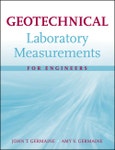Cost effective, high quality testing of geo-materials is possible if you understand the important factors and work with nature wisely. Geotechnical Laboratory Measurements for Engineers guides geotechnical engineers and students in conducting efficient testing without sacrificing the quality of results.
Useful as both a lab manual for students and as a reference for the practicing geotechnical engineer, the book covers thirty of the most common soil tests, referencing the ASTM standard procedures while helping readers understand what the test is analyzing and how to interpret the results.
Table of Contents
PREFACE.ACKNOWLEDGEMENTS.
PART I
Chapter 1 Background Information for Part I.
Scope.
Laboratory Safety.
Terminology.
Standardization.
Evaluation of Test Methods.
Precision and Bias Statements.
Laboratory Accreditation.
Proficiency Testing.
Technician Certification.
Unit Convention.
Significant Digits.
Test Specification.
Sampling.
Processing Bulk Material.
Test Documentation.
Spreadsheets.
Reporting Test Results.
Typical Values.
Further Reading and Other References.
References.
Chapter 2 Phase Relationships.
Scope and Summary.
Typical Materials.
Background.
Typical Values.
Calibration.
Specimen Preparation.
Procedure.
Precision.
Detecting Problems with Results.
Reference Procedures.
References.
Chapter 3 Specific Gravity.
Scope and Summary.
Typical Materials.
Background.
Typical Values.
Calibration.
Specimen Preparation.
Procedure.
Precision.
Detecting Problems with Results.
Reference Procedures.
References.
Chapter 4 Maximum Density, Minimum Density.
Scope and Summary.
Typical Materials.
Background.
Typical Values.
Calibration.
Specimen Preparation.
Procedure.
Precision.
Detecting Problems with Results.
Reference Procedures.
References.
Chapter 5 Calcite Equivalent.
Scope and Summary.
Typical Materials.
Background.
Typical Values.
Calibration.
Specimen Preparation.
Procedure.
Precision.
Detecting Problems with Results.
Reference Procedures.
References.
Chapter 6 pH and Salinity.
Scope and Summary.
Typical Materials.
Background.
Typical Values.
Calibration.
Specimen Preparation.
Procedure.
Precision.
Detecting Problems with Results.
Reference Procedures.
References.
Chapter 7 Organic Content.
Scope and Summary.
Typical Materials.
Background.
Typical Values.
Calibration.
Specimen Preparation.
Procedure.
Precision.
Detecting Problems with Results.
Reference Procedures.
References.
Chapter 8 Grain Size Analysis.
Scope and Summary.
Typical Materials.
Background.
Typical Values.
Calibration.
Specimen Preparation.
Procedure.
Precision.
Detecting Problems with Results.
Reference Procedures.
References.
Chapter 9 Atterberg Limits.
Scope and Summary.
Typical Materials.
Background.
Typical Values.
Calibration.
Specimen Preparation.
Procedure.
Precision.
Detecting Problems with Results.
Reference Procedures.
References.
Chapter 10 Soil Classification and Description.
Scope and Summary.
Typical Materials.
Background.
Calibration.
Specimen Preparation.
Procedure.
Precision.
Detecting Problems with Results.
Reference Procedures.
References.
PART II
Chapter 11 Background Information for Part II.
Scope and Summary.
Intact Sampling.
Processing Intact Samples.
Reconstituting Samples.
Transducers.
Data Collection and Processing.
References.
Chapter 12 Compaction Test Using Standard Effort.
Scope and Summary.
Typical Materials.
Background.
Typical Values.
Calibration.
Specimen Preparation.
Procedure.
Precision.
Detecting Problems with Results.
Reference Procedures.
References.
Chapter 13 Hydraulic Conductivity: Cohesionless Materials.
Scope and Summary.
Typical Materials.
Background.
Typical Values.
Calibration.
Specimen Preparation.
Procedure.
Precision.
Detecting Problems with Results.
Reference Procedures.
References.
Chapter 14 Direct Shear.
Scope and Summary.
Typical Materials.
Background.
Typical Values.
Calibration.
Specimen Preparation.
Procedure.
Precision.
Detecting Problems with Results.
Reference Procedures.
References.
Chapter 15 Strength Index of Cohesive Materials.
Scope and Summary.
Typical Materials.
Background.
Typical Values.
Calibration.
Specimen Preparation.
Procedure.
Precision.
Detecting Problems with Results.
Reference Procedures.
References.
Chapter 16 Unconsolidated-Undrained Triaxial Compression.
Scope and Summary.
Typical Materials.
Background.
Typical Values.
Calibration.
Specimen Preparation.
Procedure.
Precision.
Detecting Problems with Results.
Reference Procedures.
References.
Chapter 17 Incremental Consolidation By Oedometer.
Scope and Summary.
Typical Materials.
Background.
Typical Values.
Calibration.
Specimen Preparation.
Procedure.
Precision.
Detecting Problems with Results.
Reference Procedures.
References.
APPENDICES.
Appendix A Constants And Unit Conversions.
Appendix B Physical Properties Of Pure Water.
Appendix C Calculation Adjustments For Salt.
INDEX.
Samples

LOADING...








